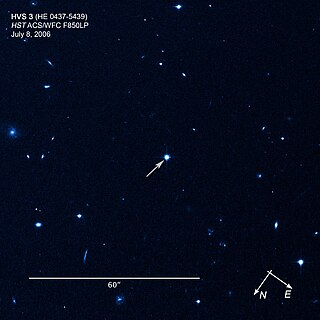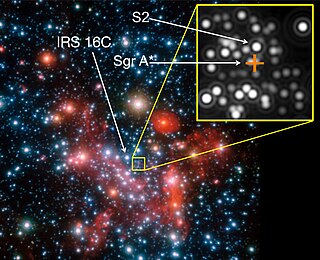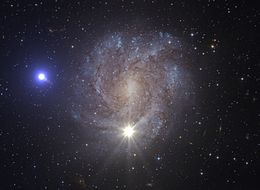
A supernova remnant (SNR) is the structure resulting from the explosion of a star in a supernova. The supernova remnant is bounded by an expanding shock wave, and consists of ejected material expanding from the explosion, and the interstellar material it sweeps up and shocks along the way.

Spiral galaxies form a class of galaxy originally described by Edwin Hubble in his 1936 work The Realm of the Nebulae and, as such, form part of the Hubble sequence. Most spiral galaxies consist of a flat, rotating disk containing stars, gas and dust, and a central concentration of stars known as the bulge. These are often surrounded by a much fainter halo of stars, many of which reside in globular clusters.

An intermediate-mass black hole (IMBH) is a class of black hole with mass in the range 102–105 solar masses: significantly more than stellar black holes but less than the 105–109 solar mass supermassive black holes. Several IMBH candidate objects have been discovered in the Milky Way galaxy and others nearby, based on indirect gas cloud velocity and accretion disk spectra observations of various evidentiary strength.

Gaia is a space observatory of the European Space Agency (ESA), launched in 2013 and expected to operate until 2025. The spacecraft is designed for astrometry: measuring the positions, distances and motions of stars with unprecedented precision, and the positions of exoplanets by measuring attributes about the stars they orbit such as their apparent magnitude and color. The mission aims to construct by far the largest and most precise 3D space catalog ever made, totalling approximately 1 billion astronomical objects, mainly stars, but also planets, comets, asteroids and quasars, among others.
The Sloan Digital Sky Survey or SDSS is a major multi-spectral imaging and spectroscopic redshift survey using a dedicated 2.5-m wide-angle optical telescope at Apache Point Observatory in New Mexico, United States. The project began in 2000 and was named after the Alfred P. Sloan Foundation, which contributed significant funding.

Intergalactic travel is the hypothetical crewed or uncrewed travel between galaxies. Due to the enormous distances between the Milky Way and even its closest neighbors—tens of thousands to millions of light-years—any such venture would be far more technologically and financially demanding than even interstellar travel. Intergalactic distances are roughly a hundred-thousandfold greater than their interstellar counterparts.

SDSS J090744.99+024506.8 is a short-period variable star in the constellation Hydra. It has a Galactic rest-frame radial velocity of 709 km/s.

The Milky Way is the galaxy that includes the Solar System, with the name describing the galaxy's appearance from Earth: a hazy band of light seen in the night sky formed from stars that cannot be individually distinguished by the naked eye. The term Milky Way is a translation of the Latin via lactea, from the Greek γαλαξίας κύκλος, meaning "milky circle". From Earth, the Milky Way appears as a band because its disk-shaped structure is viewed from within. Galileo Galilei first resolved the band of light into individual stars with his telescope in 1610. Until the early 1920s, most astronomers thought that the Milky Way contained all the stars in the Universe. Following the 1920 Great Debate between the astronomers Harlow Shapley and Heber Doust Curtis, observations by Edwin Hubble showed that the Milky Way is just one of many galaxies.

HE 0437-5439 is a massive, unbound hypervelocity star (HVS), also called HVS3. It is a main sequence B-type star located in the Dorado constellation. It was discovered in 2005 with the Kueyen 8.2-metre (320 in) telescope, which is part of the European Southern Observatory's Very Large Telescope array. HE 0437-5439 is a young star, with an age of around 30 million years. The mass of the star is almost nine times greater than the mass of the Sun and the star is located 200,000 light years away in the direction of the Dorado constellation, 16 degrees northwest of the Large Magellanic Cloud (LMC) and farther away than the LMC. The star appears to be receding at an extremely high velocity of 723 kilometres per second (449 mi/s), or 2,600,000 kilometres per hour (1,600,000 mph). At this speed, the star is no longer gravitationally bound and will leave the Milky Way galaxy system and escape into intergalactic space. It was thought to have originated in the LMC and been ejected from it soon after birth. This could happen if it originally was one of a pair of stars and if there is a supermassive black hole in the LMC.
A pulsar kick is the name of the phenomenon that often causes a neutron star to move with a different, usually substantially greater, velocity than its progenitor star. The cause of pulsar kicks is unknown, but many astrophysicists believe that it must be due to an asymmetry in the way a supernova explodes. If true, this would give information about the supernova mechanism.

The Andromeda–Milky Way collision is a galactic collision predicted to occur in about 4.5 billion years between the two largest galaxies in the Local Group—the Milky Way and the Andromeda Galaxy. The stars involved are sufficiently far apart that it is improbable that any of them will individually collide, though some stars will be ejected.

GRO J1655−40 is a binary star consisting of an evolved F-type primary star and a massive, unseen companion, which orbit each other once every 2.6 days in the constellation of Scorpius. Gas from the surface of the visible star is accreted onto the dark companion, which appears to be a stellar black hole with several times the mass of the Sun. The optical companion of this low-mass X-ray binary is a subgiant F star.

RX J0822−4300, often referred to as a "Cosmic Cannonball", is a radio-quiet neutron star currently moving away from the center of the Puppis A supernova remnant at over 3 million miles per hour, making it one of the fastest moving stars ever found. Astronomers used NASA's Chandra X-ray Observatory to observe the star over a period of five years to determine its speed. At this velocity the star will be ejected from the galaxy millions of years from now.

In astronomy, stellar kinematics is the observational study or measurement of the kinematics or motions of stars through space.

S2, also known as S0–2, is a star in the star cluster close to the supermassive black hole Sagittarius A* (Sgr A*), orbiting it with a period of 16.0518 years, a semi-major axis of about 970 au, and a pericenter distance of 17 light hours – an orbit with a period only about 30% longer than that of Jupiter around the Sun, but coming no closer than about four times the distance of Neptune from the Sun. The mass when the star first formed is estimated by the European Southern Observatory (ESO) to have been approximately 14 M☉. Based on its spectral type, it probably has a mass of 10 to 15 solar masses.

Sagittarius A is a complex radio source at the center of the Milky Way, which contains a supermassive black hole. It is located in the constellation Sagittarius, and is hidden from view at optical wavelengths by large clouds of cosmic dust in the spiral arms of the Milky Way. The dust lane that obscures the Galactic Center from a vantage point around the Sun causes the Great Rift through the bright bulge of the galaxy.

An intergalactic star, also known as an intracluster star or a rogue star, is a star not gravitationally bound to any galaxy. Although a source of much discussion in the scientific community during the late 1990s, intergalactic stars are now generally thought to have originated in galaxies, like other stars, before being expelled as the result of either galaxies colliding or of a multiple-star system traveling too close to a supermassive black hole, which are found at the center of many galaxies.

A subdwarf O star (sdO) is a type of hot, but low-mass star. O-type subdwarfs are much dimmer than regular O-type main-sequence stars, but with a brightness about 10 to 100 times that of the Sun, and have a mass approximately half that of the Sun. Their temperature ranges from 40,000 to 100,000 K. Ionized helium is prominent in their spectra. Gravity acceleration is expressed by log g between 4.0 and 6.5. Many sdO stars are moving at high velocity through the Milky Way and are found at high galactic latitudes.
The Hills mechanism is a phenomenon that occurs when a binary star system is disrupted by a supermassive black hole.
S5-HVS1 is an A-type main-sequence star notable as the fastest one detected as of November 2019, and has been determined to be traveling at 1,755 km/s (3,930,000 mph). The star is in the Grus constellation in the southern sky, and about 29,000 light-years from Earth. According to astronomers, S5-HVS1 was ejected from the Milky Way galaxy after interacting with Sagittarius A*, the supermassive black hole at the center of the galaxy. It is possible that it was originally part of a binary system that was tidally disrupted by the supermassive black hole, causing it to be ejected. If this is the case, that it was flung out of the galaxy by the central black hole, it is then the first example of a star that has undergone the Hills mechanism.



















